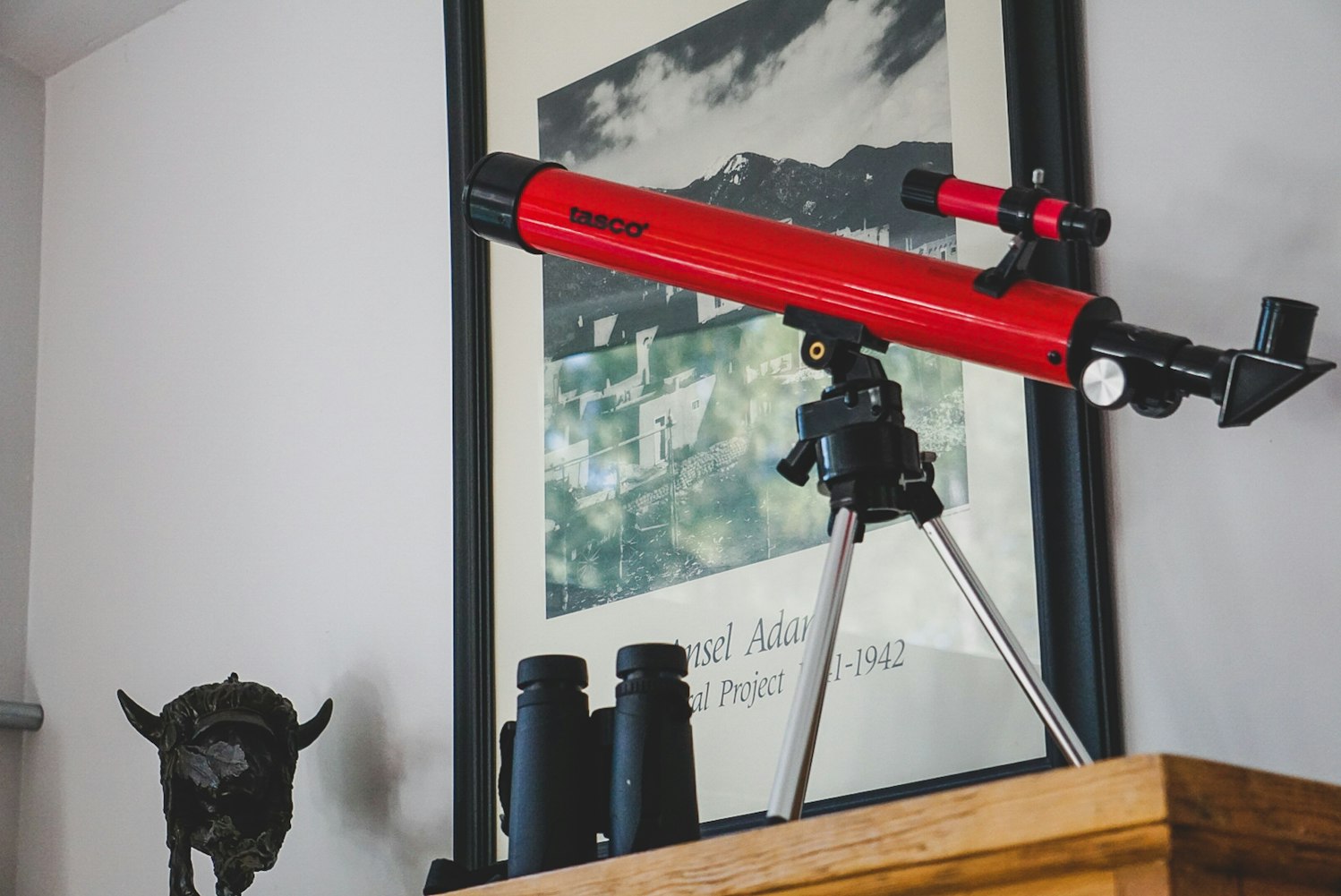image source: Unsplash
The original spyglass was a refracting telescope. The earliest type of optical telescope was invented in 1608 by three people from the Netherlands: Hans Lippershey, Zacharias Janssen and Jacob Metius. By 1609, Galileo made his own design after hearing of the invention. Since then, many advancements have been made and the refractor telescope has become a key element in astronomical observation.
What Is a Refracting Telescope?
A refracting scope, also known as a dioptric telescope, is a type of optical scope that uses a lens as its objective to form an image. Using a glass lense arranged in a metal tube, a refracting telescope gathers light from distant objects, such as the moon, or even farther away, like star clusters and nebulae. The lens bends light as it passes through the tube—a process known as refraction—and collects more light than the human eye can collect on its own. Some telescopes can be used to study astronomical objects in extraordinary detail when used in combination with interchangeable magnifying eyepieces.
Unfortunately, it is difficult and expensive to manufacture large diameter versions of these scopes so it is good for bright objects. However, it will not have enough light-gathering to see the really faint objects in the deep sky.
When comparing, telescopes that refract light offer better clarity than those that reflect light. Reflecting telescopes distort color and are more expensive than refracting telescopes. Refracting telescopes are usually less expensive and simple to use and understand. They also provide very sharp views and don’t need much maintenance.
How They Work
image source: Unsplash
Refractor telescopes use a combination of a curved lens and an eyepiece to project an image to the viewer. The objective lens works by focusing light into a small beam that is directed into the eyepiece.
The objective lens collects a bright light from a distant object and brings that light to a point of clarity and focus to where it is presented as an image to the viewer. The eyepiece then takes the bright light from the objective lens and magnifies it to take up a larger portion of space. You can focus the eyepiece to attain better clarity, and it is often designed with a ninety-degree angle for the comfort of the viewer.
A telescope’s quality can be determined by two factors: how well it can collect light and how much it can magnify the image.
Also known as aperture, the ability to collect light is in direct relation to the diameter of the lens. The larger aperture means it can collect more light, and a brighter image results for the viewer. With sealed refractor scopes, the aperture cannot be changed. This is why aperture is the most important factor when deciding on a new telescope.
Magnification refers to the telescope’s ability to enlarge an image, which depends on the combination of lens within the scope along with the eyepiece. With any type of telescope, the magnification can be changed by the eyepiece.
When Would You Use A Refracting Telescope?
image source: Unsplash
A refracting telescope can be used for viewing bright objects in the sky, like the moon. There are special filters and equipment that allow viewers to look at the sun; you shouldn’t try looking at the sun without them.
A Few Tips For Beginners
Go easy on the magnification. Using too much will cause blurry images and a narrow view of the sky, making it difficult to see and locate objects. Magnification is also affected by vibrations from the scope’s mount and turbulence from the atmosphere. If you lose your sense of what you are looking for, try using a pair of binoculars to examine the sky.
What To Look For
The moon is the easiest target to find in the night sky with your new telescope. Even the smallest telescopes will show craters and other details of the moon’s surface. Try using the largest eyepiece you have, and use the focus knob to bring the features of the moon into clear view. Also look for the terminator, where the light meets the darkness in the moon’s surface and where shadows are the longest; craters here can be seen in detail.
After the sun falls and the darkness rises, the planet Jupiter will be the brightest object in the sky since it is the largest planet in our solar system. Unfortunately, in recent years, the Big Red Dot of Jupiter has been harder to spot.
There is also the Hyades star cluster that surrounds Jupiter. It can be seen best by using the lowest magnification. It is one of the two-star clusters closest to Earth. The other star cluster is known as the Pleiads star cluster, which is slightly west and 10 degrees north of Jupiter.
How Do You Use A Refracting Telescope?
image source: Unsplash
Refractor telescopes provide the simplest setup and the closest thing to a “point-and-shoot” telescope as you can get.
Keep in mind that sources of light can make it difficult to see through a telescope. Try to stay away from porch lights, street lights or any other sources that would brighten the night sky, for best results. Also, if it is a particularly cold or warm night, let your scope sit out for 20 minutes so that it can adjust to the temperature.
Recommended Equipment
A Planisphere can help you easily see the stars above you on any date and at any time. It is a star chart instrument to assist you in learning how to recognize stars and constellations.
Although, if you want to see how those stars change over time, check out Stellarium. It’s a free software program that will show you the night sky of any place and time. The control panel is well-designed, but it can take some time to get the hang of it. If you need help, there is a video tutorial.
A red flashlight can help protect your night vision when outside using your telescope and a Thermos with your favorite hot drink will help keep you warm while observing.
Setting Up Your Telescope
First, set up the tripod by extending each leg to the same length, and secure them by tightening the thumb screws on each leg. This can be easier if you lay it in on the ground or table. Then, loosen the screw on the mounting bracket, and attach the telescope to the tripod. Make sure the screws are tight. Then do the same for the viewfinder scope.
Choosing The Right Magnifying Eyepiece
It is a common misconception about magnification, that if zoomed in, the viewer will get a clearer image. It’s actually the opposite. If you find yourself struggling to get a clear focus on an object, try using a lower power lens. However, when used correctly, stronger magnifying eyepieces can produce greater detailed images.
Also, the smaller number on the eyepiece gives a higher magnification, but it also depends on the scope. A 10mm eyepiece will be lower on a short-focal-length refractor and will only provide 40 times magnification, but the same eyepiece on a 10-inch telescope will give you 300 times magnification.
An eyepiece collection that comes with most scopes usually includes one low, one medium and one high-power. The usual magnification range depends on the scope, but for most, the normal range tends to be from 50 times to 250 times magnification.
Cleaning Your Refracting Telescope
It is essential to keep your refractor telescope clean and in the best condition possible. However, before attempting to clean, determine what cleaning is required. That old saying, “Don’t fix it unless it’s broken,” definitely applies here because improper cleaning techniques can cause permanent damage.
If there is only dust, a camel hair brush can be used to gently sweep any dust particles from the surface of the lens. If there are any heavier particles, there is a chance those will scratch the lens. For this reason, it is important to take careful inspection and consideration before actually cleaning your lens.
Another tip: don’t try to blow any particles off the lens yourself. Saliva and small particles can be difficult to remove if they settle on the lens. Instead try using canned air, the same that’s used to clean computers. It can be found at just about any hobby or office supply store. If there happen to be fingerprints or dirt on the glass, don’t rub it! Fortunately, there are many types of solvent-cleaning solutions that the lens can be soaked in and then simply air-dried. Wiping the lens dry can cause smears, resulting in cloudy images.
One reason why refractor telescopes are great for beginners is the fact that it is a sealed unit. Only the exposed surfaces need cleaning. It’s important to remember that refractor telescopes cannot be disassembled since potentially-dangerous gases were probably used in the sealing process.
Conclusion
Refracting telescopes are recommended for new stargazers and backyard astronomers. It is useful for viewing objects within our own solar system. For a beginner, consider getting a refractor with 60mm to 70mm of aperture.
Refracting telescopes tend to be rugged. Once aligned, their optical system is more resistant to misalignment than the reflector telescopes. The glass surface inside the tube is sealed from the atmosphere so it should never need cleaning. Also, since it is sealed, it is less likely to be affected by air currents and changing temperatures.




Leave a Reply